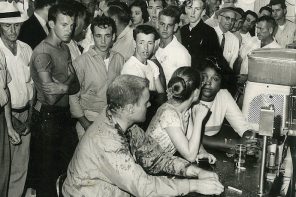As if Barack Obama’s presidential election was not confounding enough for conservatives, now they’ve got an Obama-as-Jesus meme to contend with.
Jamie Foxx referred to Obama as “our lord and savior” at the Soul Train Awards on November 8, and Michael D’Antuono’s painting of Obama as Christ analogue (“The Truth”) is back on display. With a crown of thorns and arms stretched out to look as if he is on a cross, this painted Obama has riled the right wing punditry, from Glenn Beck to Bill Donohue.

Lost in the uproar are several historical points: first, this is not the first piece of art to depict Obama as a Christ figure; nor is this the first piece of American art to depict a black man as Jesus; and, finally, this is not the first piece of American art by a white individual that portrays an African American figure as God’s son.
Depictions of Obama as a messianic figure are nothing new. Since his emergence at the Democratic National Convention in 2004, Obama has become an icon of salvation. One statue had him in a robe, with a neon halo around his head; another had him riding a donkey just as Jesus had done for his “triumphal entry.” This kind of religio-political art left some conservatives wondering if Obama was actually the “anti-Christ.”
In the course of the last one hundred years American artists have used black men as referents for Christ many times. Marcus Garvey’s Universal Negro Improvement Association of the early twentieth century not only pushed for African Americans to move to Africa, but also sold images of Jesus as black. During the Harlem Renaissance, when black poets like Countee Cullen wished that “He I served were black,” artists M. Gray Johnson and Fred Bucholz depicted lynched southern black men as neo-Christ figures. These images, in tandem with poems by Langston Hughes and short stories by W. E. B. Du Bois, used lynch victims from the cotton South as the analogues for Christ in America.
But it is not only African American poets and artists who have had a vision of Jesus as black—many of these portrayals have been created by white women and men. (I’d argue that these examples complicate the idea put forth by scholars like Jaroslav Pelikan and Stephen Prothero that humans simply portray Jesus “in their own image.”) During the Harlem Renaissance, Prentiss Taylor and Julius Bloch—both white—offered gripping artistic works of southern black men as crucified Christ figures. Then in the late twentieth century, Janet McKenzie, a white woman originally from upstate New York, wowed viewers with her “Jesus of the People.” In this case, Jesus appears somewhat African, somewhat Native American, and somewhat feminine. It won the National Catholic Reporter’s award for “Jesus 2000” competition. And, in the case of D’Antuono, he is not a person of color.
So why are conservatives reacting so vociferously to the liberal depiction of Obama as Christ?
Obama “sacrificed” bears different meaning than a lynch victim “crucified.” A crown of thorns on the head of the most powerful American connotes something quite distinct from Marcus Garvey invoking a black Jesus to convince African Americans to get out of America.
As history reminds us, images shift their meaning with every era—this one, no matter how contested, is clearly telling us something unique to our moment.




